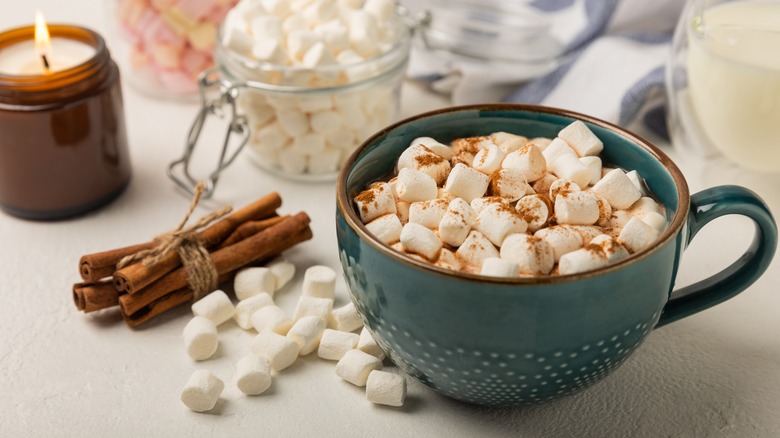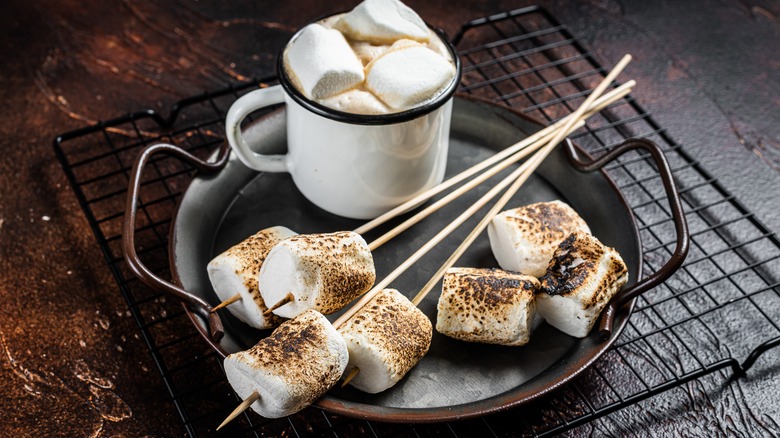Do Marshmallows Actually Expire?
It's easy to forget that every food item expires, even if it's a pantry staple that seems as if it can go without spoiling till the end of time. Take the sugar, grains, oils, and canned foods sitting in your kitchen, for example. When was the last time you saw mold or anything that looked remotely off-putting on them? The same goes for fluffy marshmallows — they simply don't seem like things that would start to rot on you. But while there may be some truth to this, marshmallows don't exactly stay fresh indefinitely.
Most marshmallows are made from three things: sugar, gelatin, and corn syrup. Each of the three ingredients is known to have an indefinitely long shelf life when treated with care, so it's only fair to assume that so would a sweet confection that was made from it. Technically speaking, marshmallows come with best-by or best-before dates rather than expiration ones and as such, do not expire in the way that you would expect fresh produce to. While expiration dates are strict deadlines that indicate when a food item is no longer safe for eating, best-by dates are markers of taste, quality, and freshness. So while marshmallows aren't generally unsafe to eat past the date written on the pack, their quality will certainly deteriorate over time.
How long do marshmallows stay fresh?
Marshmallows tend to stay fresh for anywhere between two to six months when left unopened though the exact time frame will vary depending on the manufacturer and the ingredients used to make them. For example, marshmallows that don't have any preservatives to extend their shelf life will have a shorter best-by date so it's always good to go by what's written on the pack. In general, the fluffy pillows should stay fresh for a month or two beyond the best-by date, possibly longer if they contain preservatives. If you'd like to keep the marshmallows in top condition for even longer, you could freeze unopened packs for up to six months past their best-by dates.
Once opened, the clock will start ticking on the freshness of the sugary confections. Open marshmallows should be okay for another week — possibly two — when kept at room temperature in a cool and dark place away from heat and light, and up to three months in the freezer once the best-by date passes. When going off of best-by dates, however, nothing is ever set in stone; it's always best to check your marshmallows for signs of quality damage before you go ahead and pop them into thick hot chocolates or toast them for gooey s'mores.
Signs your marshmallows have seen better days
If you're waiting for green mold, black fungus, or putrid liquids to ooze out of your marshmallows before tossing them out, you will likely be waiting forever. Marshmallows will not rot as most perishable foods do, but certain signs will indicate that the soft pillows are past their prime. The biggest indicator of a marshmallow's quality is its texture. Marshmallows should have a sponge-like squishiness to them, so if they feel rock-hard or have melted into a semi-solid sticky mess from exposure to heat, they've certainly seen better days. They will still be safe to eat but the texture and flavour will leave much to be desired.
The smell is an excellent indicator too — stale odor or anything else suspicious is a sign that the quality of the marshmallow has dropped for the worse. The same goes for any color change, or if the marshmallows feel chewier when bitten into and taste anything but sweet and sugary. Another way to discern the quality of marshmallows is to carefully inspect the packaging — bugs like sugar as much as humans do and marshmallows have plenty of it. Look for any tears or holes as these are usually signs that your bag of sugary goodness is now a breeding ground for insects. You could still use these marshmallows (as long as they are bug-free of course) but don't be surprised if they don't melt, smell, taste, or feel the way they should.



